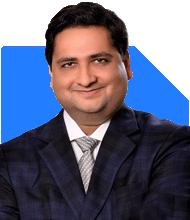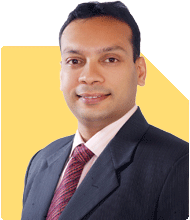Ramalingam Kalirajan |5367 Answers |Ask -Follow
Mutual Funds, Financial Planning Expert - Answered on Apr 11, 2024
He has an MBA in finance from the University of Madras and is a certified financial planner.
He is the director and chief financial planner at Holistic Investment, a Chennai-based firm that offers financial planning and wealth management advice.... more

Hi Gurus, I'm 37+, monthly take home salary 2.17 Lakhs, married (wife working, earning decent salary, no kid as of yet). I contribute 32.4k pm (12% EPF + 10% VPF) towards PF (balance ~27 Lakhs), 14.7k pm towards NPS as Employer's contribution + 50k yearly towards Tier2 (balance ~11.6 Lakhs), 1.5 Lakhs yearly towards PPF (balance ~11.3 Lakhs) and have couple of LIC plans with SA ~11 lakhs maturing in 10 years. I also have MF SIP of 50k pm as below (total portfolio value ~19.7 Lakhs with small holdings in International Funds) which I wish to top up by 15% every year. 1. Kotak Small Cap - 3000 2. Axis Small Cap - 3000 3. Edelweiss Mid Cap - 3000 4. PGIM Mid Cap - 3000 5. PGIM Flexi Cap - 3000 6. Parag Parikh Flexi Cap - 5000 7. Quant Active Fund - 5000 8. Edelweiss Bal. Advtg. Fund - 3000 9. Mirae Assets L&M Cap - 5000 10. Canara Robeco Emerging Equity - 3000 11. Canara Robeco Bluechip - 3000 12. SBI Focused Equity - 5000 13. ICICI Pru. Focused Equity - 3000 14. Edelweiss US Tech ETF FoF - 3000 I have my own loan free home, health insurance from the company, no term insurance and a liquid emergency fund of 12 Lakhs. My average monthly expenses are around 1.3 Lakhs. I know I'm heavily into equity without having the balance of Debt or Gold, but for that reason I contribute towards FI instruments like PF, PPF as much as possible. Also I'm aware that my MF portfolio has become over diversified over the years. My ultimate financial target is to accumulate 10cr by my late 50s. Could you please suggest how far or diverted I am from my target and what all adjustments should I make to my overall investment portfolio.
Diversification: While equity can provide high returns over the long term, ensure you have adequate diversification across asset classes. Consider allocating a portion of your portfolio to debt instruments like bonds or fixed deposits for stability.
Insurance: Since you don't have term insurance, consider purchasing a policy to provide financial security to your dependents in case of any unfortunate event.
Review MF Portfolio: Consolidate and streamline your mutual fund holdings to avoid over-diversification. Focus on high-quality funds with proven track records and consider reducing the number of funds to simplify your portfolio management.
Goal Planning: Reassess your financial goals and time horizon periodically to ensure your investments are aligned with your objectives. Consider seeking professional advice to develop a comprehensive financial plan tailored to your needs.
Regular Review: Continuously monitor the performance of your investments and make adjustments as necessary to stay on track towards your long-term financial goals.
By making these adjustments and staying disciplined in your investment approach, you can work towards achieving your target of accumulating 10 crores by your late 50s.
You may like to see similar questions and answers below
Hardik Parikh |106 Answers |Ask -Follow
Tax, Mutual Fund Expert - Answered on Apr 11, 2023
Ramalingam Kalirajan |5367 Answers |Ask -Follow
Mutual Funds, Financial Planning Expert - Answered on Jul 15, 2024
Dr Nagarajan J S K |58 Answers |Ask -Follow
Health Science and Pharmaceutical Careers Expert - Answered on Jul 27, 2024
Dr Nagarajan J S K |58 Answers |Ask -Follow
Health Science and Pharmaceutical Careers Expert - Answered on Jul 27, 2024
Dr Nagarajan J S K |58 Answers |Ask -Follow
Health Science and Pharmaceutical Careers Expert - Answered on Jul 26, 2024
Krishna Kumar |358 Answers |Ask -Follow
Workplace Expert - Answered on Jul 26, 2024
Krishna Kumar |358 Answers |Ask -Follow
Workplace Expert - Answered on Jul 26, 2024
Krishna Kumar |358 Answers |Ask -Follow
Workplace Expert - Answered on Jul 26, 2024
Krishna Kumar |358 Answers |Ask -Follow
Workplace Expert - Answered on Jul 26, 2024
Krishna Kumar |358 Answers |Ask -Follow
Workplace Expert - Answered on Jul 26, 2024
Krishna Kumar |358 Answers |Ask -Follow
Workplace Expert - Answered on Jul 26, 2024
Krishna Kumar |358 Answers |Ask -Follow
Workplace Expert - Answered on Jul 26, 2024




















